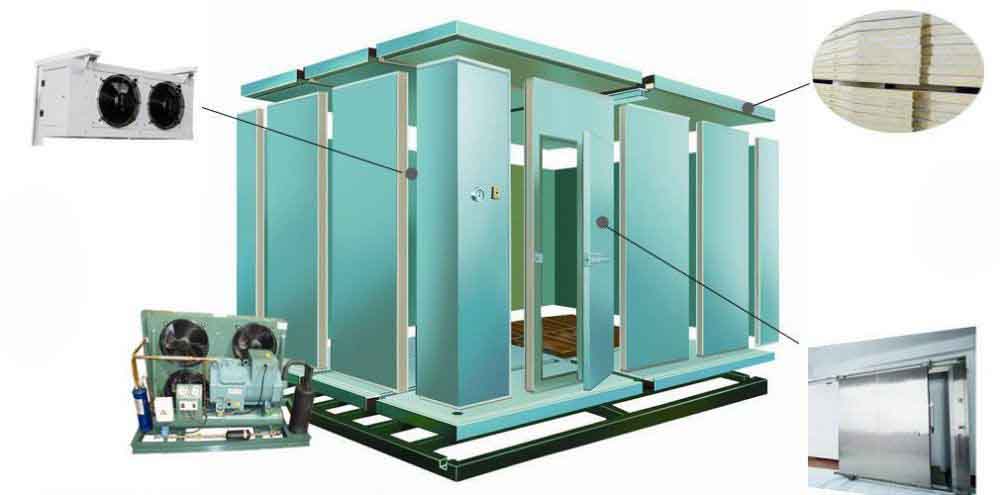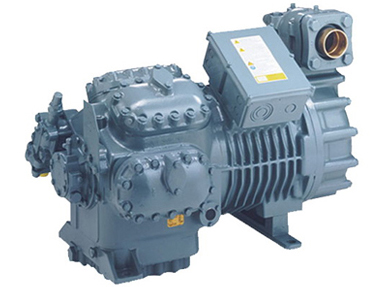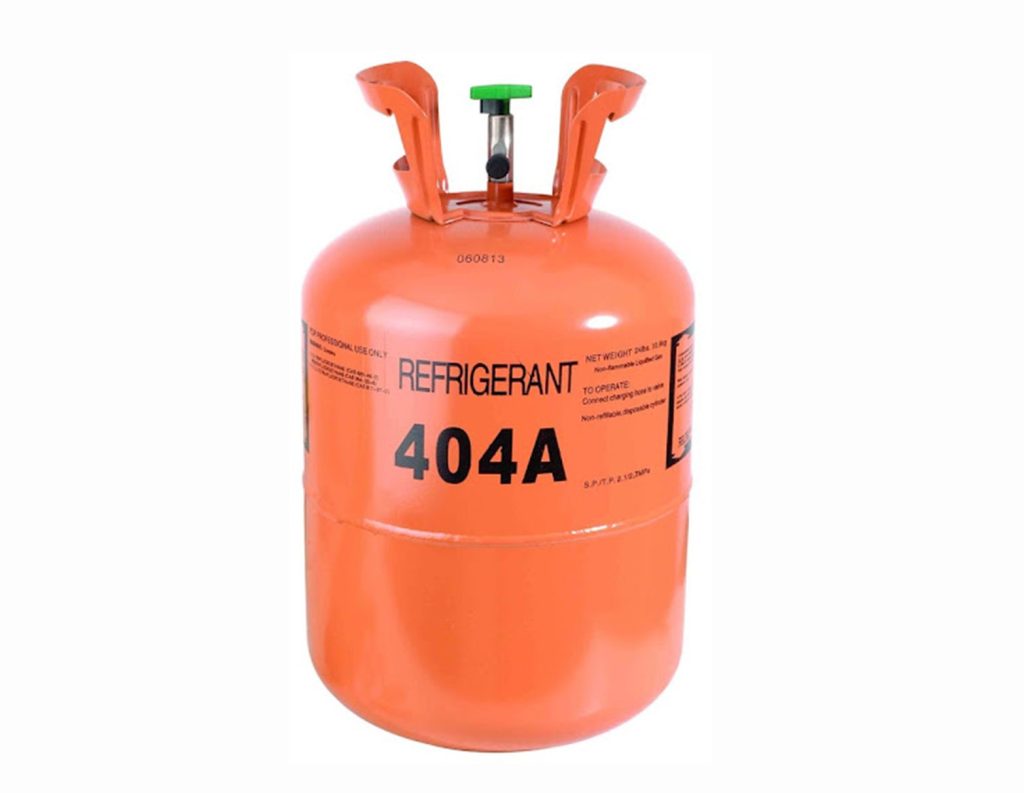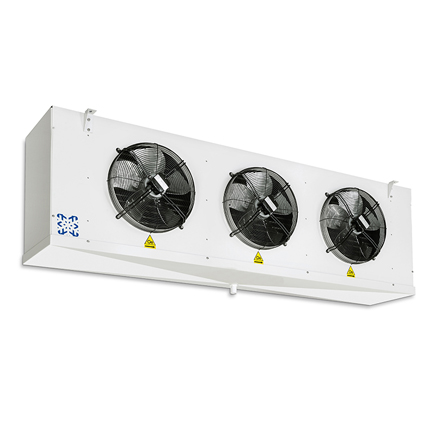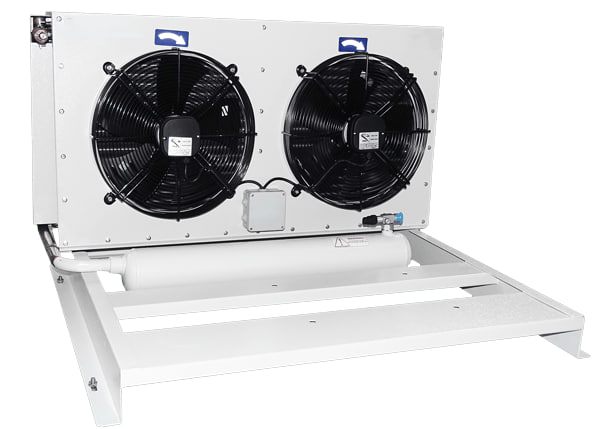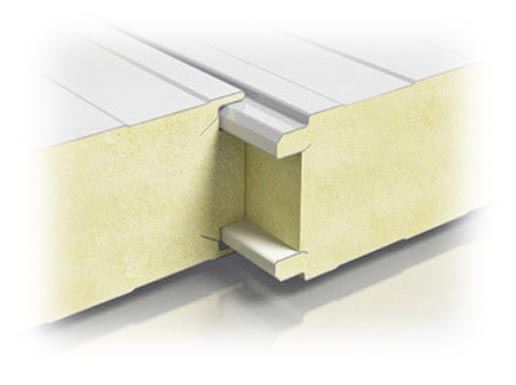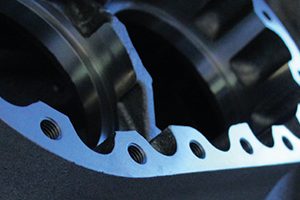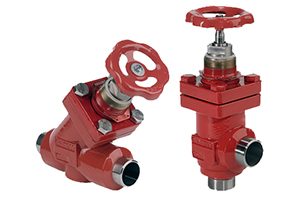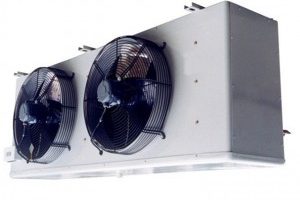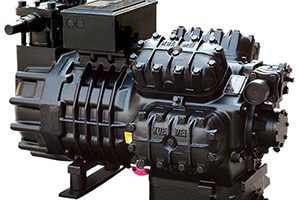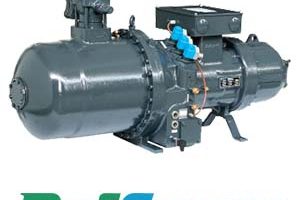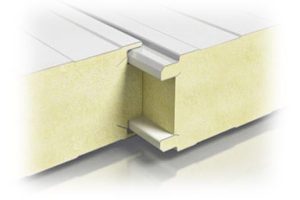Cold Storage Equipment
Cold storage equipment encompasses a variety of machines and devices specifically designed to store perishable goods at low temperatures under controlled conditions. Key components include the compressor, condenser, and evaporator. In addition to these, cold storage systems also incorporate electrical panels, valves, control devices, monitoring, and protection equipment. This section provides a general overview of the essential machinery and equipment involved in constructing a cold room.
Cold Room Compressor
Cold room compressors come in a variety of types and classifications, based on factors such as function (screw or reciprocating), refrigerant type (ammonia or freon), construction (hermetic, semi-hermetic, and open-type), and compression stages (single-stage or two-stage). The compressor is essentially the heart of the refrigeration cycle and the core of industrial cold room equipment. It is selected and designed according to specific needs and budget constraints. Some of the most reliable brands in the industry include Grasso, Sabroe, Mycom, Danfoss, Copeland, Bitzer, Refcomp, and Bock.
Types of Cold Room Compressors
Selecting the right compressor is crucial for the effective operation of cold storage as it significantly impacts cooling efficiency and operational stability. Below, we introduce the various types of compressors commonly used in cold room construction, categorized by their structure and performance.
Piston or Reciprocating Compressors
Reciprocating compressors, also known as piston compressors, are among the most commonly used in refrigeration systems, including cold storage construction. Operating similarly to an internal combustion engine, these compressors utilize pistons driven by a crankshaft to compress the refrigerant. Known for their reliability and efficiency, reciprocating compressors are suitable for a wide range of applications, from small refrigerators to large industrial refrigeration systems.
Screw Compressors
Screw compressors use two interlocking helical rotors to compress the refrigerant. They are particularly effective for large-scale refrigeration systems due to their ability to handle higher volumes of refrigerant and maintain consistent pressure. Screw compressors are known for their durability, high efficiency, and ability to operate smoothly with minimal vibration, making them ideal for industrial and commercial applications.
Scroll Compressors
Scroll compressors use two interleaved spiral elements to compress the refrigerant. One of the spirals is fixed, while the other orbits around it, creating compression pockets. This design offers high efficiency, low noise levels, and fewer moving parts, which reduces the likelihood of mechanical failure. Scroll compressors are commonly used in residential and light commercial applications due to their compact size and reliable performance.
Cold Storage Refrigerants
R22: Also known as chlorodifluoromethane, R22 is a hydrochlorofluorocarbon (HCFC) refrigerant widely used in air conditioning and refrigeration systems for decades. Its special thermodynamic properties result in high performance, making it a popular choice for residential and commercial applications. However, its release into the atmosphere poses significant environmental disadvantages.
R134a: Tetrafluoroethane (R134a) is a hydrofluorocarbon (HFC) refrigerant commonly used in high-temperature systems such as car air conditioners and home refrigerators. While R134a has a relatively low global warming potential (GWP) compared to older refrigerants like R12, it is being phased out in favor of more environmentally friendly alternatives due to its contribution to greenhouse gas emissions.
R404A: This refrigerant is a blend of three HFCs and is widely used in commercial refrigeration, including display refrigerators, cold storage freezers and ice makers. R404A performs well at low temperatures but has a high GWP, leading to its gradual replacement under international regulations aimed at reducing environmental impact.
Natural Refrigerants: Natural refrigerants such as ammonia (R717), carbon dioxide (R744), and hydrocarbons like propane (R290) and isobutane (R600a) are highly favored due to their excellent thermodynamic properties and low environmental impact.
Ammonia (R717): Known for its high efficiency and very low GWP, ammonia is commonly used in large industrial refrigeration systems. However, ammonia must be carefully managed due to its toxicity and flammability at high concentrations.
Carbon Dioxide (R744): Non-toxic and non-flammable, carbon dioxide has a very low GWP, making it an attractive option for various industrial applications. However, R744 requires specialized compressors and heat exchangers due to its high working pressure.
Hydrocarbons (R290 and R600a): These refrigerants are highly efficient with very low GWP and are often used in refinery and petrochemical units. Despite their flammability, advances in safety design have made them viable alternatives to synthetic refrigerants.
Cold Room Evaporator
The evaporator, serving as a heat exchanger, is a crucial component installed inside cold storage facilities. Its primary function is to lower the temperature within the cold room by circulating the air and passing it through its coil. Designed specifically for the operational temperature, product type, refrigerant, defrost mechanism, and capacity of the cold room, the evaporator plays a pivotal role in maintaining optimal conditions for stored goods. For detailed specifications, please refer to the evaporator page.
Cold Room Condenser
The condenser, also a heat exchanger, is another vital component of industrial cold storage systems. Its primary role is to transfer heat from inside the cold room and from the compressor to the surrounding environment. Condensers can be either air-cooled or water-cooled, depending on whether they transfer heat to air or water. When using an air-cooled condenser, it must be positioned outdoors to utilize fresh air for cooling the cold storage equipment effectively. For further details on cold storage condensers, please refer to the Condenser page.
Cold Storage Insulation
Insulation is crucial for cold storage facilities to maintain the temperature differential with the surrounding environment. Proper insulation not only helps in conserving energy but also prevents air leakage and ensures the integrity of the temperature-controlled environment. It is essential to meticulously seal all connection lines and seams to minimize energy loss and maintain efficient operation.
Types of Cold Storage Insulation
There are several types of insulation commonly used in cold storage facilities:
- Polyurethane (PUR): Polyurethane is highly regarded for cold storage insulation due to its exceptional thermal properties and robust mechanical strength. Formed by mixing isocyanate and polyol, this material creates a rigid foam that effectively insulates and is widely employed in the industry.
- Polystyrene (EPS and XPS): Polystyrene offers two main variants for insulation. Expanded Polystyrene (EPS) is lightweight with good thermal resistance, while Extruded Polystyrene (XPS) boasts higher density for improved mechanical strength and insulation performance. XPS is more costly compared to EPS.
- Polyisocyanurate (PIR): Similar to polyurethane but with enhanced temperature tolerance and fire resistance, polyisocyanurate is chosen where superior thermal performance and safety are crucial.
- Mineral Wool: Made from natural or synthetic minerals, mineral wool insulation excels in fire resistance and sound absorption. It is preferred in applications where fire safety is a priority.
Among these options, polyurethane sandwich panels are widely considered the best and most common choice for cold storage insulation due to their superior thermal efficiency and structural integrity
Temperature Control Systems
Temperature control systems are vital components of cold storage equipment, ensuring precise regulation of internal conditions to maintain the quality and safety of stored goods.
Thermostats and sensors: are the primary tools for monitoring and adjusting temperature. Thermostats maintain the set temperature by activating the cooling system when needed, while sensors provide real-time data on temperature fluctuations, ensuring consistent conditions. Automated monitoring systems: enhance these capabilities by integrating advanced technologies like IoT (Internet of Things). These systems allow for remote monitoring and control, alerting operators to any deviations via notifications. They can also log temperature data for compliance and quality assurance purposes, ensuring the reliability and efficiency of the cold storage environment.
Shelving and Racking Systems
Shelving and racking systems are essential for maximizing space and ensuring the efficient organization of goods within cold storage facilities.
Material types used for these systems must be robust and resistant to low temperatures and moisture. Common materials include stainless steel, which is durable and corrosion-resistant, and coated metal, which provides additional protection against rust.
Layout and design considerations are crucial for optimizing storage capacity and accessibility. Effective design takes into account the specific needs of the stored products, ensuring that shelves are adjustable to accommodate different sizes and weights. Proper spacing between racks allows for adequate air circulation, which is vital for maintaining consistent temperatures throughout the storage area. Additionally, ergonomic design ensures ease of access for workers, enhancing operational efficiency and safety.
10 Golden Tips for Buying Cold Storage Equipment
- Assess Your Needs:
– Determine the specific temperature requirements of the products you plan to store.
– Evaluate the storage capacity needed based on current and future demands.
– Consider the space available for the equipment installation.
- Energy Efficiency:
– Look for equipment with high energy efficiency ratings to reduce operating costs.
– Check for features like improved insulation and energy-saving modes.
- Temperature Range:
– Ensure the equipment can maintain the necessary temperature range for your products.
– Verify the accuracy and reliability of the temperature control system.
- Quality and Durability:
– Choose reputable brands known for high-quality construction and reliable performance.
– Check for durable materials and components that can withstand constant use and low temperatures.
- Compliance with Standards:
– Ensure the equipment meets relevant health and safety standards.
– Verify that it complies with local and international regulations, such as HACCP (Hazard Analysis Critical Control Point) for food storage.
- Ease of Maintenance:
– Opt for equipment with accessible parts and components for easy cleaning and maintenance.
– Look for models with self-diagnostic features that simplify troubleshooting.
- Advanced Features:
– Consider equipment with advanced features like automated monitoring systems, remote control, and alarm notifications for temperature fluctuations.
– Evaluate the benefits of smart technologies and IoT integration for real-time management.
- Vendor Support and Warranty:
– Choose suppliers that offer robust after-sales support, including installation, maintenance, and repair services.
– Check the warranty terms to ensure adequate coverage for potential issues.
- Cost Considerations:
– Balance the initial cost of the equipment with long-term operating and maintenance expenses.
– Seek competitive pricing without compromising on quality and essential features.
- Future Scalability:
– Select equipment that can be easily upgraded or expanded to accommodate business growth.
– Consider modular systems that allow for flexibility in adjusting to changing storage needs.
By carefully considering these practical tips, you can make an informed decision and invest in cold storage equipment that meets your requirements, enhances efficiency, and ensures the longevity and safety of your stored products.
Atlas Refrigeration Company boasts a long-standing legacy in designing, manufacturing, and constructing various types of cold storage and industrial cold storage equipment. For estimates on constructing small to medium-sized cold storage rooms, please click on the cold room price. Additionally, feel free to reach out to us anytime for complimentary advice from our knowledgeable sales and technical experts.
Factors Influencing the Cost of Cold Storage Equipment
Several parameters affect the price of cold room equipment, making it important to consider these factors before making a purchase. Size and capacity are primary determinants, as larger units designed to store more goods typically cost more. Temperature range and control features also play a significant role; equipment capable of maintaining ultra-low temperatures or featuring advanced temperature control systems, such as digital thermostats and automated monitoring, will be more expensive. Insulation quality impacts both the initial cost and long-term energy savings; better insulation materials like polyurethane or polystyrene provide superior performance but increase the upfront price. Additionally, energy efficiency ratings influence cost, with more efficient models often having a higher initial price but offering savings on energy bills over time. Brand reputation and reliability can also affect price, with established brands often charging a premium for their proven durability and support services. Lastly, additional features such as remote monitoring, alarm systems, and modular designs add to the cost but can enhance functionality and ease of use.
Final Thoughts on Cold Room Equipment
Investing in the right cold room equipment is crucial for ensuring the optimal preservation of perishable goods. By understanding the various types of equipment, components, and technologies available, businesses can make informed decisions that enhance efficiency, reliability, and cost-effectiveness. Factors such as size, temperature control, insulation quality, and energy efficiency should be carefully considered to meet specific storage needs and budget constraints. As advancements in smart technologies and sustainable practices continue to evolve, the future of cold storage looks promising, offering even more sophisticated and eco-friendly solutions. Ultimately, selecting high-quality cold room equipment not only safeguards products but also contributes to overall operational success and sustainability.
Extending the shelf life of cold storage equipment involves regular maintenance, proper usage, and proactive care. Performing routine inspections and timely servicing of components such as compressors, fans, and thermostats can prevent potential failures and ensure optimal performance. Keeping the equipment clean, especially the condenser coils, prevents dust and debris buildup, which can hinder efficiency and cause overheating. Ensuring proper airflow around the equipment by not overloading it and maintaining adequate clearance from walls and other obstructions enhances its operational lifespan. Additionally, using surge protectors can safeguard against electrical damage, and promptly addressing any unusual noises or performance issues can prevent minor problems from escalating into major repairs. By following these practices, the durability and efficiency of cold storage equipment can be significantly prolonged.
Related posts
Cold Room Equipment
Troubleshooting Sabroe Compressors – SMC & TSMC Series, MK4 Models Permitted Applications for Sabroe Compressors Using a Sabroe compressor outside
Ammonia Valves | Applications of Ammonia and Operating Conditions Ammonia valves play a crucial role in regulating the refrigerant within
Freon Evaporator | Components, Specifications, Design, and Selection The ATE series Freon evaporator, available in a wide range from 3
Refrigeration Compressors from Leading American, European, and Asian Brands Refrigeration compressors are essential components of cold room systems, available in
Refcamp compressor Refcamp was founded in 1991 as a refrigeration compressor manufacturer in Italy. Refcamp’s production facilities are equipped with
What is Cold Room Insulation? Cold room insulation is a vital component that prevents energy loss in cold rooms by
